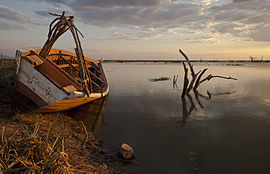Transport in Tanzania includes road, rail, air and maritime networks. The road network is 86,472 kilometres (53,731 mi) long, of which 12,786 kilometres (7,945 mi) is classified as trunk road and 21,105 kilometres (13,114 mi) as regional road. The rail network consists of 3,682 kilometres (2,288 mi) of track. Commuter rail service is in Dar es Salaam only. There are 28 airports, with Julius Nyerere International being the largest and the busiest. Ferries connect Mainland Tanzania with the islands of Zanzibar. Several other ferries are active on the countries' rivers and lakes.

Iringa is a city in Tanzania with a population of 151,345. It is situated at a latitude of 7.77°S and longitude of 35.69°E. The name is derived from the Hehe word lilinga, meaning fort. Iringa is the administrative capital of Iringa Region. Iringa Municipal Council is the administrative designation of the Municipality of Iringa. Iringa has been one of the coldest regions in Tanzania due to its geographical location but that has attracted a lot of tourists from colder regions abroad especially Western Europe. Iringa also hosts one of Africa’s largest national parks the Ruaha National Park.

Iringa is one of Tanzania's 31 administrative regions. The regional capital is Iringa. The region's population is 1,122,100. It is primarily agricultural and boasts the second-highest per-capita GDP in the country.
The Shoalhaven Scheme is a dual-purpose water supply and Pumped-storage Hydroelectricity scheme located on the South Coast region of New South Wales, Australia.

The Tanzania Electric Supply Company Limited (TANESCO) is a Tanzanian parastatal organisation established in 1964. It is wholly owned by the government of Tanzania. The Ministry of Energy and Minerals regulates the operations of TANESCO.

Nyumba ya Mungu Dam is a hydroelectric dam in Tanzania. It is in Mwanga District, Kilimanjaro Region. The water runs down the slopes of Kilimanjaro in the deep valleys. These streams pour their water into the Nyumba ya Mungu Reservoir. Nyumba ya Mungu means 'House of God'. Its installed capacity is 8 megawatts (11,000 hp).

Pangani Falls Dam is a dam in Tanzania, which is part of the Pangani Hydro Systems. The dam is located at Koani in the Muheza District of the Tanga Region, about 8 km south of another power station at Hale. The Pangani falls power station has two turbines and has an installed capacity of 68 megawatts (91,000 hp).

Kidatu Dam, also Kidadu Hydroelectric Power Station, is a 204 megawatts (274,000 hp) hydroelectric dam in Tanzania.

Kihansi Hydroelectric Power Station, is a 180 megawatts (241,384 hp) hydroelectric power station in Tanzania. The power station is reported to generate the electricity with zero carbon dioxide emission. The Tanzanian electricity utility monopoly Tanesco operates the power station on behalf of the government of Tanzania.

Hale Dam is a hydroelectric dam in Tanzania, located in the Tanga Region. Its installed capacity is 21 megawatts (28,000 hp). Thousands of people were displaced to build the dam.

The Lake Echo Power Station is a conventional hydroelectric power station located in the Central Highlands region of Tasmania, Australia. The power station is situated on the Upper River Derwent catchment and is owned and operated by Hydro Tasmania.

The Lemonthyme Power Station is a conventional hydroelectric power station located in north-western Tasmania, Australia. It is the third station in the Mersey–Forth run-of-river scheme that comprises seven conventional hydroelectric power stations and one mini hydro station.

The Great Ruaha River is a river in south-central Tanzania that flows through the Usangu wetlands and the Ruaha National Park east into the Rufiji River. Its basin catchment area is 83,970 square kilometres (32,421 sq mi). The population of the basin is mainly sustained by irrigation and water-related livelihoods such as fishing and livestock keeping.

Kiira Hydroelectric Power Station, is a hydroelectric power station in Uganda, with an installed capacity of 200 megawatts (270,000 hp).

The Rusumo Hydroelectric Power Station, also known as the Rusumo Power Station, is a hydropower plant under construction, with initial planned capacity installation of 80 megawatts (110,000 hp) when completed. The project will involve the construction of a dam, with run of river design. A more expensive 90 megawatts (120,000 hp) reservoir design was considered before being abandoned in favor of an 80 MW project with a smaller environmental impact and an estimated cost of US$300 million compared to US$400 million for the bigger project. The World Bank announced on 6 August 2013 that it had approved loans totaling US$340 million towards the US$468.60 million needed for the project. In November 2013, the African Development Bank approved a loan of US$113 million towards completion of the project.

Nshyugyezi Hydroelectric Power Station, also Nsongezi Hydroelectric Power Station, is a planned 39 megawatts (52,000 hp) hydroelectric power station in Uganda. The power project is under development, as of September 2017.

Kikonge Hydroelectric Power Station project is a proposed 300 MW (400,000 hp) hydroelectric dam in Tanzania.

Julius Nyerere Hydropower Station is a hydroelectric dam under construction across the Rufiji River in eastern Tanzania. Although controversial, the government approved the plans in 2018. The power station is expected to have an installed capacity of 2,115 megawatts (2,836,000 hp) and to produce 5,920GWh of power annually. The project, power station and dam are owned by and will be managed by the government owned Tanzania Electric Supply Company (TANESCO). Construction began in 2019 and is expected to be completed in 2022.

Malagarasi Hydroelectric Power Station, is a planned 50 megawatts (67,000 hp) hydroelectric power station in Tanzania. The development is planned in the Igamba area, west of the Malagarasi swamps, at the site of the Igamba Falls.














